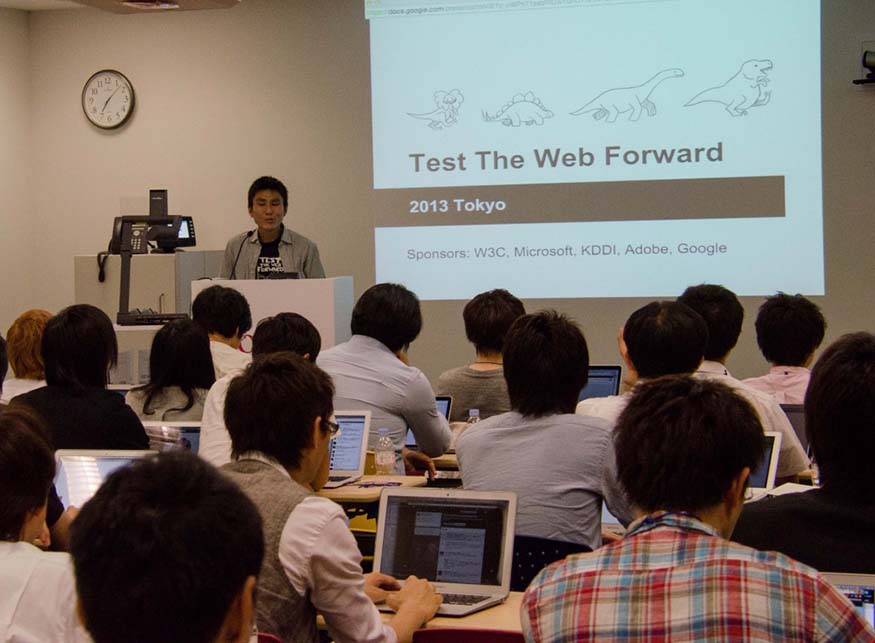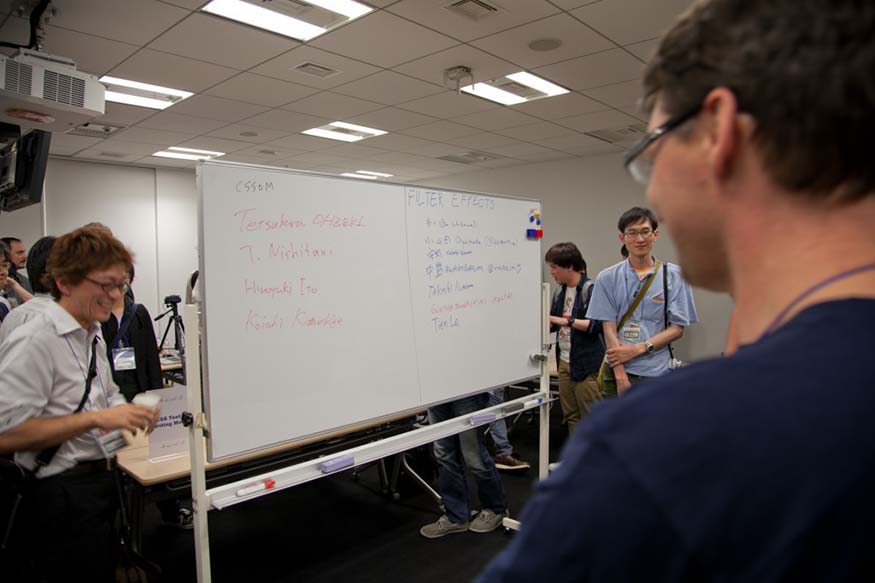Test the Web Forward Tokyo!
On the first anniversary of Test the Web Forward, we were thrilled that our Tokyo event on June 7 & 8 was a tremendous success. This is further proof that the movement has caught on globally. Early on, we were amazed by the fact that registration filled up in just 12 hours and hoped that would be a good indicator of a fantastic event. It certainly was!
Our event was one of over 30 others held that weekend for <htmlday> in Japan and was also aligned nicely with a a lot of other things: the SVG and CSS Working Groups F2F meetings, the W3C AC Rep meetings, and a W3C Developer Meetup immediately following TestTWF in the same building. Many web developers and enthusiasts came together to learn, teach, demo, network, and have their voices on the Web heard. For two days, we all gathered in Google Japan's spectacular office on the 27th floor of the Mori Tower in Roppongi Hills.
Friday, June 7 – Day 1

Things kicked off on Friday night with a special guest and keynote speaker, Shigeo Okamoto from the Japanese Ministry of Internal Affairs and Communications. Mr. Okamoto spoke to a packed room of 100 people, delivering a message on the importance of Web Standards to the Japanese government.
Following Mr. Okamoto was Kazuaki Takemura, a very active test writer for CSS Text and Writing Modes to deliver the traditional TestTWF talk on How to Read W3C Specifications. Then came Oli Studholme to talk about a new topic that arose from the Q & A session at TestTWF Seattle. Someone there asked a simple question, "After I write and submit tests, then what happens?" Oli stepped up and gave an excellent talk on Specifications and Test Lifecycles.
The lightning talks were next, where experts made 3 minute pitches to get people to write tests for their favorite specs:
Lightning talk photo credits: HTML5J

We took a short break after the lightning talks and reconfigured the room into seven areas, each with a large table with a whiteboard beside it. This was something new at this event, with experts standing by each table to recruit testers for their specs, job-fair-style. Attendees returned to the room, floated among the tables, and signed up for a spec on the whiteboards. It was great to see nearly everyone commit to come back the next day. There was virtually no drop-off in attendance the next day. The two largest groups were HTML5 and Shadow DOM, but each whiteboard had at least 5-7 names.
For the remainder of the evening, we mingled as we ate dinosaur sushi and drank beer and green tea.


Saturday June 8 – Day 2
We all returned and started the next morning with our two How To talks - one for testharness.js and one for reftests. Daniel Davis, previously of Opera and recently hired by the W3C, made a beautiful Japanese testharness.js deck and delivered a fantastic talk. I then gave the reftest talk, using a deck that was translated by Andy Hall from Adobe Japan. The final bit of vital information was delivered by Elika "fantasai" Etemad, where she summarize the key steps to follow when writing tests:
- Identify or synthesize the test assertion. Be very precise!
- Construct the test scenario.
- Assert the pass/fail result.
- Review the test:
- Ensure the test passes when it should pass.
- Ensure the test fails when it should fail.
- Confirm it tests what it thinks it's testing.
The hacking then began and it was a very productive day. We were pleased to see the experts leading their groups very well. There were a lot of questions being answered, tests being reviewed, and just general strong support at each team table. A really good rhythm of gongs and applause began to fill the day. As we saw in Seattle, there were remote participants. Our friends and TestTWF alumni, Odin Hørthe Omdal, James Graham, and Ms2ger emerged in IRC from their respective timezones and began reviewing tests as they started to come in. As is usually the case, some attendees chose specs not highlighted or pitched and we had the highest number of specs covered to date - 16!
After a great couple of days of learning, hacking, reviewing, and gonging, we were elated that Tokyo took the new TestTWF World Record for the most tests, with the preliminary count of 609. We've since combed through the data and have an adjusted total of 732! Of these, approximately 60% were reviewed and merged during the event.
Special Thanks
We must thank our good friends and organizing partners at Google for successfully bringing the movement to Japan. Eiji Kitamura, Alex Danilo, Fumi Yamazaki, and the whole crew at Google Japan have a strong commitment to Making a Better Web and were instrumental to the success of this event. We're excited to see more TestTWF events in Japan in the future!

